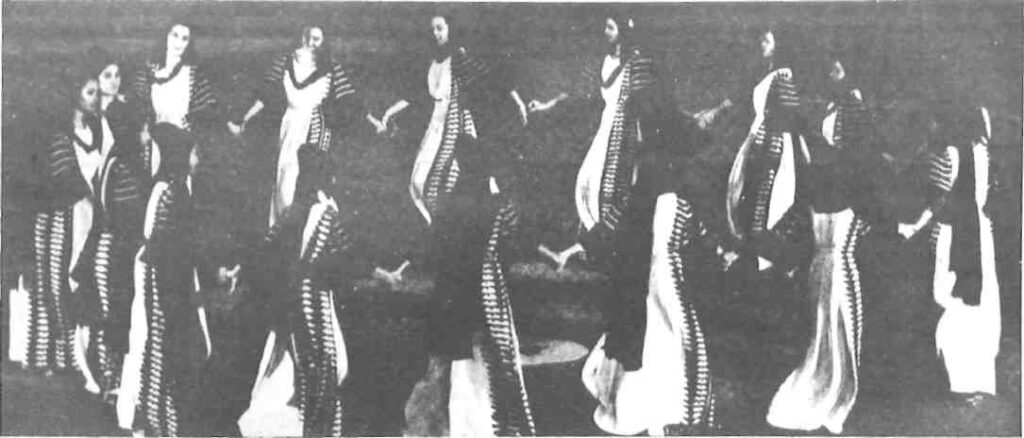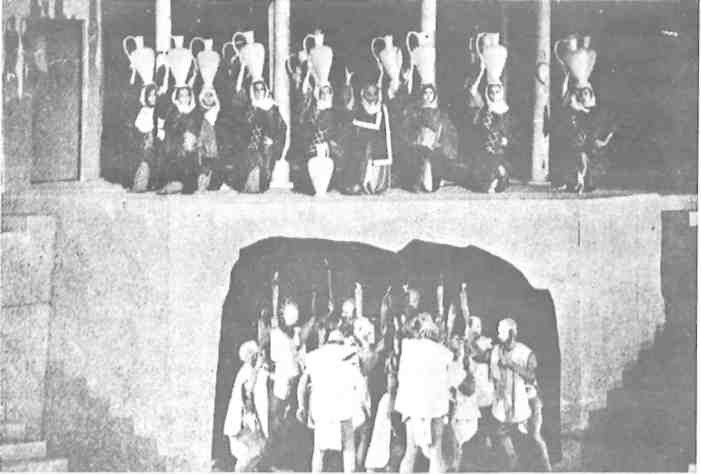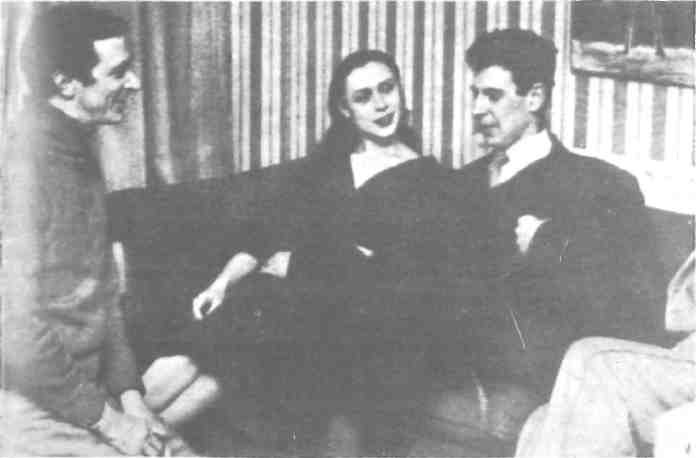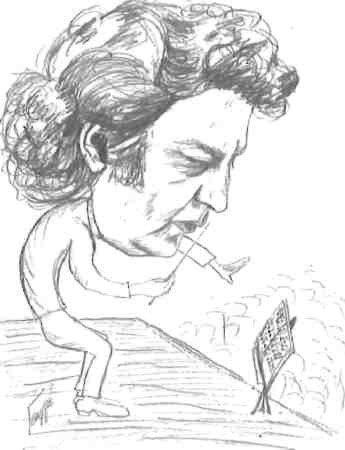Music for ancient drama has been one of the major concerns of modern Greek composers. Since the inception of festivals of ancient drama in modern Greece — begun in the 1920s by the American Eva Palmer, and her husband, the Greek poet Angelos Sikelianos — interest has increased, producing remarkable results. The great number of plays that have survived from ancient times, their ageless and universal appeal, the fact that they were intended to be performed with music and cannot be properly performed without it, make composing music for the ancient plays a rewarding and challenging task. Regardless of the composers’ approaches, most scores share certain characteristics. Scenes commence with a prelude, and are joined by entr’actes. The score may include lyric sections that reinforce the action, with the use of special sound effects, or remain independent of it. Sections may accompany a scene, running parallel to the action, or echoing the suffering of the hero.
Greek composers have experimented with many approaches, used various instrumentation — from the traditional concert orchestra instruments to folk, jazz, and electronic — and written in many styles — from the Western European classical tradition to the most avant-garde electronic methods. Others, such as Manos Hadzidakis, as in his scores for Frogs and Wasps, have used modern folk songs and rhythms.

Mikis Theodorakis’s long involvement with music for ancient drama, and the philosophical and musical problems it presents, has influenced his approach to all his compositions. He has brought to his music the ancient concept of oneness of poet, composer and people. His approach to the classical element through Byzantine modes and folk melody can be seen in two early symphonic compositions, Prometheus Bound, and Oedipus Rex, written in 1946. It would lead eventually to his forming the belief that the modern Greek composer, ‘following his own true nature’, must search for the musical language of his country in an attempt not only to make music relevant to people but to discover what elements are common to both the classical Greek mind and the modern, conveyed over the ages by the language, the rhythm and the natural surroundings.
Theodorakis’s ballet score for Orpheus and Euridice, composed in 1952, digressed from this course, however, incorporating as it does the most modern trends prevailing in music at the time. It was not until he composed his ballet score for Antigone that Theodorakis’s probing search resolved itself, revealing to the composer the direction his music should take. Premiered in 1959 by the Royal Ballet Company at Covent Garden with choreography by John Cranko, it won Theodorakis his first acclaim in the West, with A.L. Haskell in London Musical Events declaring Theodorakis’s score to be ‘a magnificent example of writing for narrative ballet’.
Creatively, if not theoretically, the score for Antigone reveals Theodorakis at a crossroads. It was an experimental investigation not only of modern, Western-oriented music but of the ancient Greek modes. Several years later he was to say: ‘When I was writing Antigone, I used mathematical computations so extensively that I felt the lack of knowledge of mathematics. Then I saw two roads open to me. I could either improve my mathematics or attempt a radical return to the roots. The work itself, Antigone, offered the solution.’ Indeed, at the beginning of Antigone, where for seven minutes the chorus accompanies the dead to their home, simple Byzantine motifs supported by simple harmonization supply the background. The chorus section is delicate and smooth. Tn this,’ he has said, ‘lies the success of Antigone. In this part my own true self was to be found. It was then that I realized that my road was to return to the roots.’ Thus, Theodorakis turned his back on the artificialities of electronic and other mathematical devices embraced by Xenakis and others.
When he returned to Greece in 1959, he began to apply his theories to his compositions: through his song cycles, in which he set to music the works of the nation’s great poets, such as Ritsos, Seferis, and Elytis, just as ancient Greek poetry was set to music, and through his oratorios, popular songs, and scores for the cinema. By drawing on the inherited wealth of music and themes relevant to the times, he made all of the Greek people participants in a musico-cultural renewal.

Theodorakis’s first score for ancient drama was the Phoenician Women, produced under the direction of Alexis Minotis, and presented in 1960 at Epidavros. In the choral parts he had followed the German concept of recitative and the effect seemed lifeless. With the cooperation of Minotis, Theodorakis had the choral parts sung, and the results met with applause from the critics. Theodorakis, however, was not satisfied. Drama in ancient Greece was a synthesis, an indissoluble complex of poetry, melody, and dance. The rhythms of the music were practically identical with the metres of the poetry so that the type of music corresponded to the type of poetry. The words, the lyrics themselves contain hidden music, and the composer, he believed, must listen to and develop their sound and rhythm, and adjust the music to the spirit of the individual author and to the particular plot so that every word is balanced and under conscious control.
In ancient drama the action of the characters and the movements of the chorus were woven into the music. The drama itself sublimates the role of vocal articulation. This Theodorakis sought to achieve with pure instrumentation in an attempt to express the moment when human passion has no words. The music, in a sense, is to serve as the chorus in commenting upon, appraising, or sympathizing with the suffering of the protagonist. The music should illustrate the dramatic action, expressing the emotional essence of the human conflicts but without singling out individual personalities: faceless, hidden behind the mask, so to speak, yet conveying the subtleties of the dramatic characters and heightening the dramatic conflict. The composer must try to perfect the harmony of the word, music, and body movement. In Theodorakis’s words:
‘The music for tragedy must reach such clarity, substantiality, and simplicity as to be imperceptible… it must unite either materially with the outcries of the chorus or hero, or dynamically with the intensity of the tragic moment to such an extent that it is not heard; instead it should always remain an integral extension of a movement, or a rhythm, or a high point in a break.’
It was with these ideas fresh in mind that he composed the music for Sophocles’s Ajax, presented at Epidavros in 1961 under the direction of Takis Mouzenidis, and began work on a score for Euripides’s Bacchae, the most challenging of the ancient plays in terms of rhythm and melody, especially in the choral parts, to be presented during the 1962 summer festival season. The chorus, Theodorakis decided, should not only sing, but dance and play musical instruments.
Successful presentations of ancient drama do not depend only on the talents of composer and director and their ability to cooperate, but on many other factors as well. To begin with, the composer, director, designer, and others involved in the productions must consider the structure of each ancient theatre, its natural environment and unique acoustics, while taking into consideration the heavy weight of literary and sacred tradition which often envelopes classical drama in an aura of sanctity that discourages experimentation. Furthermore, on a more mundane level, scores for ancient drama are written on a contractual basis, become the property of the individual producer, and reflect his taste — and that of the state machinery whose agent he is.

Hardly had Theodorakis completed the choral parts for the Bacchae when the government, disconcerted by Theodorakis’s growing political support among the people, stepped in and assigned the task to Manos Hadzidakis. By then the chorus had become enthusiastic about Theodorakis’s ideas concerning the dance and instruments, and Hadzidakis had to go along. By 1965, however, the political climate had changed for the better and the National Theatre of Greece presented Euripides’s Trojan Women at Epidavros with Theodorakis’s music. The following year he wrote the score for Aristophanes’s Lysistrata, up until then his most progressive musical work for comedy. Directed by Minos Volanakis, it was performed more than thirty times at Anna Synodinou’s outdoor theater on Mount Lykavittos, the theatre established by the famous tragedienne when she broke with the director of the National Theatre, Alexis Minotis. Comedy, achieving a different catharsis than does tragedy and reflecting the immediacy of the socio-political climate, allowed Theodorakis to take greater liberties. The predominant element in his score for Lysistrata was the rhythmic control of the musical phrases and the economy of the instrumentation. The choral parts were naturalistic and simple, with the melodic motifs freer and the orchestration in a lighter vein.
The Lysistrata score was his last, however, for staged ancient drama. By the summer of 1967 the Papadopoulos dictatorship was established in Greece, and among the many things the colonels banned were performances of some ancient dramas. Although the director 1 of the National Theatre, Alexis Minotis, at first refused to take a stand on this censorship, the outcry around the world eventually forced him to comment. Minotis denied that censorship had been imposed on the texts of the ancient tragedies; the state simply did not want Theodorakis’s music to be played, he explained. ‘Since three of the tragedies originally scheduled for this year’s Athens and Epidavros festivals had music by Theodorakis,’ he said, ‘the Board of Directors of the National Theatre, in consultation with the Ministry of Education and Religion, decided to eliminate them.’
In spite of such international attention, it was through his various film scores that Theodorakis gained popular recognition outside of Greece, In 1962 he had collaborated with director Michael Cacoyannis on a filmed version of Sophocles’s Electra.
The Man Behind the Myth
Search as one may in the poetic texts that I have used [in my compositions] one will not find any political slogans. One will find neither obvious nor hidden propaganda concerning specific political viewpoints. Consequently the politicization of my art is exclusively the result of two causes: its forthrightness, and my personal commitment.’ Thus wrote Mikis Theodorakis in 1972 in an introduction to Mikis Theodorakis: Music and Social Change. And so it is, unless one considers humanitarian issues to be purely political. Yet the composer’s art is often eclipsed in the minds of critics and the populace by the public political figure, and further obscured by the violent enmity of the right and dogmatic left-wing reactions to his views.
Michalis Theodorakis was born on July 29, 1925, the son of Aspasia Poulakis, a Smyrniot who came to Greece with her family after the Asia Minor Disaster of 1922, and Yiorgos Theodorakis, a Cretan. Mikis grew up in many parts of Greece as his father, a lawyer by training but a civil servant by profession, was transferred from post to post. Thus, in addition to his Asia Minor and Cretan inheritances, he is intimately familiar with the many and varied cultures that make up the Greek mosaic: He lived on the Aegean islands of Chios, Syros, Limnos, and Lesbos; in Northern Greece in Yannina; on the Ionian island of Cefalonia and in the Peloponnisos in Patras, Pyrgos, and Tripoli.

Although active in music from childhood, he began his formal training at the Patras Conservatory. He came to Athens in 1943, where his family settled in Nea Smyrni, and entered the Athens Conservatory, but his studies were repeatedly interrupted by the political turmoil that gripped the country at the time, and by his many imprisonments for his political activities during the Civil War and the reign of terror that followed. He graduated from the Conservatory cum laude in 1950.
It was through his activities in EPON (the left-wing All Greek Youth Organization) during the 1940s that he met Manos Hadzidakis and other young artists, many of whom he would work with in the future. During his exiles to the islands of Ikaria and Makronissos, he met many creative people with whom he would also work in time, as well as Grigoris Bithikotsis who ten years later became his lead singer.
He married Myrto Altinoglou, a medical doctor, in 1953. In the following year they moved to Paris where he studied at the Paris Conservatory, and his wife at the Foundation Curie. He studied with Olivier Messiaen, Eugene Bigot and Pierre Ancelin, analyzing extensively with the latter the works of Hungarian composer Bela Bartok, whose experiments with the folk music of his country greatly influenced the Greek musician. During this time he worked closely with the now famous avant-garde, Greek composer, Yiannis Xenakis who, condemned to death in absentia for his political activities during the Civil War, had settled in France where he still lives. Although working on technical problems related to composing, the two musicians were most interested in the creation of a national style of composition, but Xenakis was drawn to the aesthetics of Boulez and Messiaen and he and Theodorakis came to a parting of the ways.
Among those who took an interest in Theodorakis’s work was conductor Dimitris Mitropoulos who attempted to help Theodorakis to perform in the United States. He was not granted a visa to enter the country. Nonetheless, in 1959 he won the American Copley Music Prize as the best European composer of the year. In 1957 he won the First Gold Award at the Moscow Prior to this he had written scores for a number of films made in Greece and abroad but this was the composer’s first attempt to write music for filmed ancient tragedies. With Irene Papas in the title role, Electra was the first of Cacoyannis’s trilogy of filmed ancient tragedies that includes Trojan Women made in 1971. Theodorakis last month completed the score for Iphigenia in Aulis currently being filmed.
Cacoyannis’s intention in Electra was to transfer the emotional content of the poetic lines to the movements and portrayals of the tragic characters themselves: the emotional is expressed visually while the poetical line is cut and distributed in the dialogue. Thus the power of the dramatic dialogue is not only sustained but heightened. The need for music in many scenes in Electra is so great that in its absence the scenes would have to be eliminated: the music is so identified with the drama that it equals ‘action’.
The result is a dramatic unity, the music reflecting the harsh, dry, rough landscape — which is an integral part of the expanded ancient stage — and serving as counterpoint to the action and emotion. Although it is not incorporated into the poetic text, it follows, serves, and comments upon the drama, and has virtually the same effect upon the listener whether heard with the film or not. Sublime, passionate, powerful, and lyrical, the score delicately weaves together the perfect economy required by drama as theatre and cinema as a visual art.
Theodorakis’s score consists of entire strophic melodies, Greek melodic motifs, not ‘tunes’ to be recalled, flowing behind the speech and conflict of the heroes. They are worked out with such artistry that they cannot be separated from the total synthesis. Three major elements exemplify the emotional overtones of the drama by means of different musical effects: the agony of man is emphasized with the rhythms of Cretan tunes and dance (the ancient pyrrhic dance), and the wailing of the stringed instruments which the composer used to approach as closely as possible the tonal quality of the ancient lyra. To express extreme tragic despair, or to interject the strident, piercing cries of human terror and fear, the baglama (a miniature bouzouki) interrupts the strings. The death throes, which sound as if a real animal were perishing, are expressed in the dirge-like nasal sounds of the brass instruments, mainly the clarinet, occasionally interrupted by the percussive sound of pieces of wood being struck. (These instruments are used even now by the monks on Mt. Athos.) Brass instruments used for the scores of Ajax and Trojan Women are used, too, in Electra. Together the music and instruments in Electra create a primitive atmosphere and suggest the primordial nature of man.
Theodorakis’s score for Cacoyannis’s Trojan Women faithfully followed the director, whose aim was to produce a work as primitive as possible with speech, action, and dramatic tone touching the very essence of human passion and tragedy. The score allows for greater use of instruments — santouri, sitar, electric guitar, and bass violin — with sounds that bring one’s feelings even closer to man’s primordial nature.
Theodorakis, it would seem, has indeed achieved in all his scores for ancient drama, for both stage and cinema, the unity of logos (poetic line), mousiki (performed melody), and orchesis (rhythmical movement). Evaluating his recent work, he has said: ‘Always having as my model ancient tragedy, I conceived the work of this period as a canvas on which the figures and ideas of our era could be embroidered, and more specifically, the events and ideas that distress the Greek people.’
This seems to be the summation of Theodorakis’s belief about the way to approach the music written for ancient drama or inspired by the ancient dramatic musical sound. The composer must be involved in both the creative process of the classical drama and the modern human drama. In this way he may fulfill the three-fold function of the creator: drama, music, and performance.







